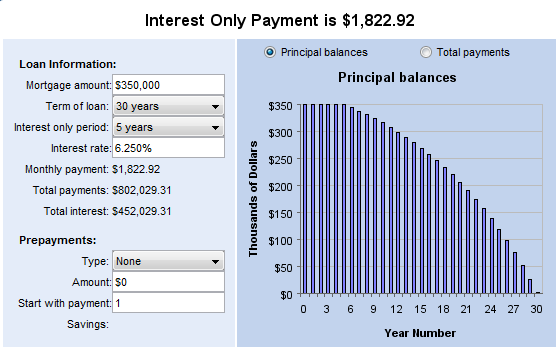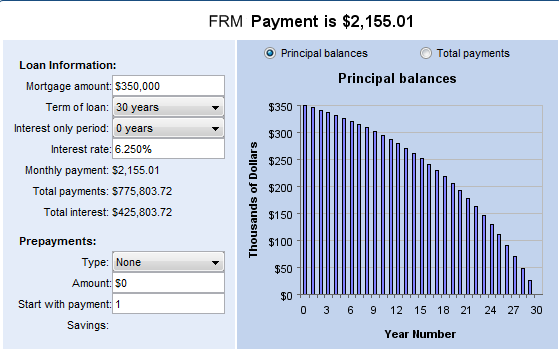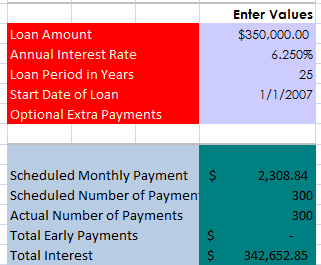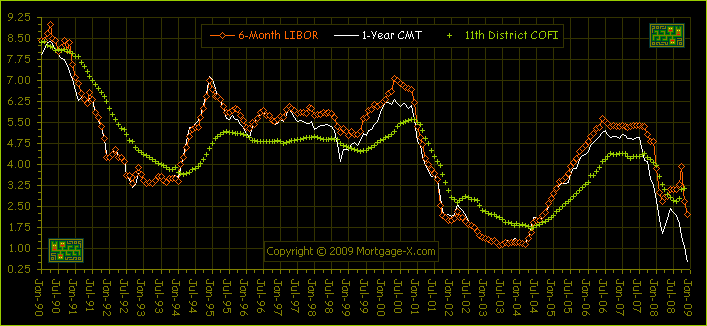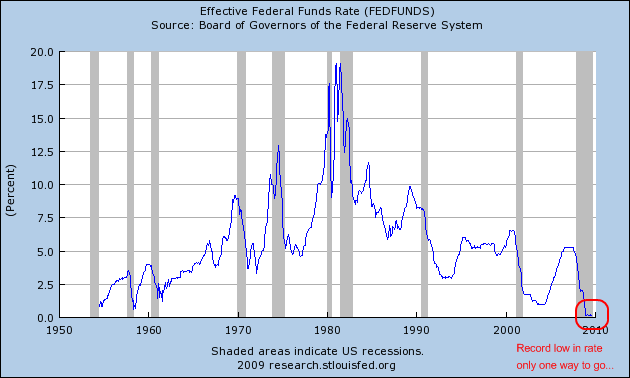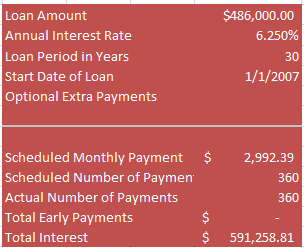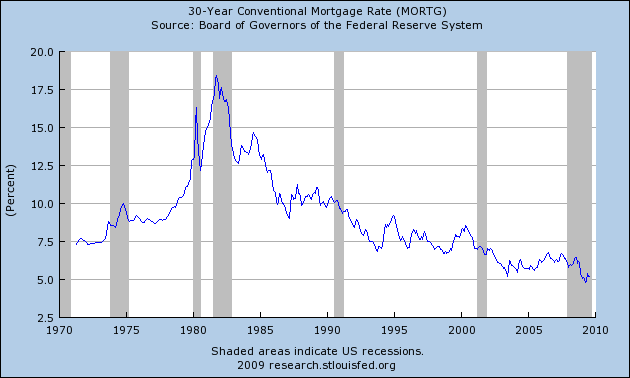Interest Only Mortgage Time Bomb: $71 billion in Loans will Reset in next 12 Months. Total Loans Outstanding at $908 Billion. Average Balance of $324,000. Median U.S. Home Price $178,000.
- 3 Comment
Interest only (IO) loans seemed like a viable mortgage option when home prices were appreciating on a double-digit basis every year. The interest only loan allowed borrowers the option of making no principal payments for 5, 7, or even 10 years. Now why would someone not make any principal payment for such a long time? The way these mortgages were pitched, people would buy a home for 3, 5, or 7 years and would sell their home before the reset period. Yet the housing bubble has burst and home prices are now below the average balance of these mortgage in many areas. Recent data has the median U.S. home price at $178,000 while the average loan amount of an interest only loan is $324,000. How many of these loans are out there? Try 2.8 million. Many in overpriced states that have taken the brunt of the housing downturn.
As I discussed before, option ARM loans are a smaller amount of loans with a total amount of $189 billion outstanding. The option ARM will have more problems simply because borrowers went with even less than interest only, they went with the negative amortization option. That is, their principal balance is now higher than when they initially purchased the home. With interest only and option ARM loans you pay on the front-end for this riskier product. Borrowers simply looked at the initial payment and ignored points, recast dates, reset periods, and the inevitable payment jump after a few years. These loans are products of an ideal market with no home price declines. That is the only thing that could destroy these loans but not only did we get lower prices, we got a crashing housing market.
In many scenarios, a 30-year fixed rate mortgage will have a lower wholesale rate to an IO loan of about .375%. This assumes a 20 percent down payment that very few did in the last decade. Many borrowers that elected to go with interest only payments have been virtually renting their home for 3, 5, or 7 years. Over the long run, assuming all else is equal, interest only loans will cost the borrower more money and more interest:
We’ll use a simple example to illustrate. The first example is an IO loan with a 5 year period. For the first five years, the balance remains at $350,000. No principal is touched. Over the long run the borrower will pay $802,000 in total payments. Now look at the fixed rate mortgage. Over the long run the borrower will make $775,000 in total payments. Plus, at year five the balance is down to $332,000. But the major appeal was that monthly mortgage payment. $2,155 versus $1,822. Even the payment becomes a problem once the mortgage fully amortizes with principal and interest on a 25 year horizon:
After five years the payment will jump to $2,308 from $1,822. This is a jump of 26 percent and we are using a perfect scenario here. The reality is, many loans will reset to 50 or even 75 percent higher for a couple of reasons:
a. Teaser Rates
b. Most made IO payment with no principal
Just because you have an interest only loan does not mean you have to make the minimum payment. Borrowers had the option to make payments that covered the principal but like those that took out option ARMs the incredible majority did not. And this jump of about 26 percent seems to be in line with real world examples:
“(NY Times) Dean Janis, a Southern California lawyer who bought a $950,000 home in 2004, will see his interest-only loan reset in December. He calculates that will send his payments up a minimum of 27 percent, to $3,726. A rise in rates could eventually push it as high as $6,700.
“I understand I took a risk,” Mr. Janis said. “But I did not anticipate that the real estate market would go down 30 percent.” He talked with Wells Fargo about his options, and the lender said he had none.
Homeowners with interest-only loans have a much greater likelihood of default, the First American CoreLogic figures indicate. Nationally about 18 percent of prime interest-only loans are at least 60 days delinquent. In California, the level is even higher: 21 percent, a rate exceeded only in the other bubble states of Florida and Nevada.”
Here is the major gamble with those in interest only loans. They are fortunate that the current interest market is at record lows. Many of these loans are calculated by the LIBOR, COFI, or CMT and these are all at record lows:
The only reason these rates are this low is because of a couple of reasons. First the Federal Reserve is determined to destroy the U.S. dollar by keeping the Fed funds rate near zero:
The other reason is because the Federal Reserve is openly buying mortgage backed securities from the market. So right now, rates are as low as they will ever get. With our massive budget deficits our major foreign buyers are now growing weary buying our debt. What does that mean? Rates will go up. And they are so artificially low, that a slight move up will change the calculus completely. Take for example the lawyer from Southern California. A 30 year fixed mortgage of $950,000 would have this as a minimum payment:
30-year FRM
6.25% balance of $950,000
Principal and Interest:Â Â Â Â Â Â Â Â Â Â Â Â Â Â Â $5,849
At the moment, he is only paying $2,933 on an interest only loan! If this were a 30 year loan the max mortgage would be:
So if he enjoyed that initial payment and wanted it assured for the duration, he would have been able to buy a $486,000 home and have the same monthly amount due. Instead, with an interest only loan he was able to buy a home twice that amount. Now you might be asking, what would it take to push that mortgage to $6,700? From the article we know the loan is a 5 year interest only. We have to estimate since we are not given the down payment amount (if any). I would imagine for a $950,000 mortgage there must have been some down payment. But let us run a few scenarios. The home loan is still due within 30 years. So the lawyer above now has 25 years to make his payment starting this December:
Remember the balance is still $950,000 since only interest was paid for 5 years
$950,000 @ 3% PI (25 years) =Â Â Â Â Â Â Â Â $4,505
$950,000 @ 4% PI (25 years) =Â Â Â Â Â Â Â Â $5,014
$950,000 @ 5% PI (25 years) =Â Â Â Â Â Â Â Â Â $5,553
$950,000 @ 6% PI (25 years) = Â Â Â Â Â Â Â Â $6,120
$950,000 @ 7% PI (25 years) = Â Â Â Â Â Â $6,714
And there it is. The rate would only have to reach 7 percent for it to approach $6,700. And 7 percent on historical standards is extremely low. From 1971 the average 30 year fixed rate mortgage average has been 9.04%:
One item rarely discussed is that the Fed has no choice but to keep rates at the bottom. Now they are competing against the world and the ticking time bomb of debt. They are juicing the bubble bigger and bigger for a more spectacular crash down the road. They are fighting against the mean and historical trend. This can only go on for so long. These borrowers, most will default simply because their home prices are underwater, but with an increase in rates (the only way to go) will default even quicker. So the U.S. Treasury and Federal Reserve have decided to sacrifice the stability of our currency to keep the housing bubble going. Yet what is becoming painfully obvious with loans like interest only products is the Fed can only do so much. The option ARM and interest only loan were the ultimate culmination of a 30 year housing bubble which finally got to the point where anyone with a pulse and no down payment was able to buy a home simply buy signing a piece of paper. This is going to end bad.
If you enjoyed this post click here to subscribe to a complete feed and stay up to date with today’s challenging market!3 Comments on this post
Trackbacks
-
C said:
We might be on our way. Rumors that treasuries are being sold to foreign countries at a discount. Also, banks can buy them and earn a couple of percent with money they borrowed from the fed. We are losing at least a bank a week.
September 13th, 2009 at 7:26 pm -
robertsgt40 said:
Well diagnosed. It’s really just math now. Waiting for the other shoe to drop. Sadly, this is all by design. Greed knows no boundaries.
September 14th, 2009 at 9:27 am -
Annuity Rates said:
Still the worst is not over on sub prime crisis. But somewhere I read the next crisis getting ready with Commercial real estate. IS that true?
Thanks,
LeoSeptember 16th, 2009 at 10:44 pm
